
About UsThe Numismatic Bibliomania Society is a non-profit organization promoting numismatic literature. For more information please see our web site at coinbooks.org SubscriptionsThose wishing to become new E-Sylum subscribers (or wishing to Unsubscribe) can go to the following web page link MembershipThere is a membership application available on the web site Membership Application To join, print the application and return it with your check to the address printed on the application. Membership is only $15 to addresses in the U.S., $20 for First Class mail, and $25 elsewhere. For those without web access, write to: David M. Sundman, Secretary/TreasurerNumismatic Bibliomania
Society AsylumFor Asylum mailing address changes and other membership questions, contact David at this email address: dsundman@LittletonCoin.com SubmissionsTo submit items for publication in The E-Sylum, just Reply to this message, or write to the Editor at this address: whomren@coinlibrary.com
BUY THE BOOK BEFORE THE COINYou won't regret it! |
- WAYNE'S WORDS: THE E-SYLUM APRIL 4, 2010
- NBS WEB SITE UPDATE: A BIBLIOPHILE'S BIBLIOGRAPHY
- CORRECTION: BRYCE BROWN'S COIN AUCTION CATALOGS WEB ADDRESS
- NEW BOOK: THE MEXICAN REPUBLIC ONE CENTAVO, 1841-1905
- BOOK REVIEW: CURIOUS CURRENCY BY ROBERT D. LEONARD JR.
- COLONIAL NEWSLETTER CELEBRATES 50TH ANNIVERSARY
- DICK JOHNSON ON ADVERTISING AND THE HOBBY IN THE 1960S
- QUERY: WORLD'S GREATEST COLLECTION 1828 QUARTER BUYER SOUGHT
- QUERY: FRANK DUPEE STAMPS AND COINS
- QUERY: 1976 MONTREAL BRITISH OLYMPIC ASSOCIATION MEDAL
- QUERY: REVIEW OF NUMISMATICS AND THE LAW
- MORE ON THE MODEL FOR DRAPED BUST COINAGE
- MORE ON WARD SMITH'S PAPER MONEY PUBLICATIONS
- THE BOB CLARKE STORY
- THE COPYRIGHT REVIEW MANAGEMENT SYSTEM
- LECTURE BY AUTHOR OF "A GENTLE MADNESS"
- NOTES FROM E-SYLUM READERS APRIL 4, 2010
- MORE COIN CABINETS
- MACEDONIAN ARCHAEOLOGISTS DISCOVER ANCIENT COINS NEAR OHRID
- COMPUTERS AT THE CORE OF PCGS' NEW GRADING SERVICE OFFERING
- GERALD BLANCHARD, HIGH-TECH BANK ROBBER
- FEATURED WEB SITE: PLAY MONEY OF AMERICAN CHILDREN
WAYNE'S WORDS: THE E-SYLUM APRIL 4, 2010

Among our new subscribers this week are John W. Barber and Kenneth Marshall. Welcome aboard! We now have 1,332 subscribers.
We have a new advertiser this week - Whitman Publications. Welcome, and thank you for your support! Readers are encouraged to thank and support all of our advertisers - please click through on their ads and shop around on their web sites for additions to your numismatic library.
This week we open with an announcement relating to the NBS web site - some great new content is available for collectors of American Numismatic Literature. Next up is an announcement of a new book on Mexican coinage and a review of Leonard's Curious Currency.
Other topics this week include The Colonial Newsletter, the hobby in the 1960s, and a modern high-tech bank robber. We have a numver of queries for readers this week on topics including Olympic medals, a numismatic periodical and a mystery coin dealer. To learn about the offer of a new car for $50, Frank Dupee Stamps and Coins, Numisamtic and the Law and "galloping consumption", read on.
Wayne Homren
Numismatic Bibliomania Society
NBS WEB SITE UPDATE: A BIBLIOPHILE'S BIBLIOGRAPHY
One constant feature of early E-Sylum issues were announcements of new additions to the NBS web site bibliography, created for us by Larry Mitchell. One at a time, Larry submitted bibliography entries one subject at a time. The bibliography grew to 100 entries on primarily non-U.S. topics.
When we made the transition to the new improved NBS web site we converted the bibliography pages to a new Wiki format. Like the well-known Wikipedia, the NBS Wiki is a place where individuals can add and update content of their own.
I was pleasantly surprised recently when E-Sylum reader Tom Wetter contacted me volunteering to flesh out the Wiki bibliography for U.S. numismatics. Tom is familiar with the ways of the Wiki, and has a great collection of American numismatic literature to boot.
Tom has done a marvelous job, as you can see by browsing the updated bibliography. As a starting point, we decided to begin with the 100 Greatest Items of United States Numismatic Literature from the recently published survey by Len Augsburger for the Numismatic Bibliomania Society.
Len contributed the text from his article on the survey, and Tom recruited contributions of images and text from numismatic literature dealers including George Kolbe, David Fanning and Charlie Davis. Tom and I also contributed many images from our personal libraries. It was Tom however, who did the real work of pulling this all together on the web site. Thanks!

Tom Wetter writes:
Entries are being updated on a regular basis. The goal of the Wiki project is to create a "bibliophile's bibliography", whereas each listing is simply not just a line item, but a comprehensive listing containing all known versions, reprints & deluxe issues, minutiae, and photographs of each item. Check it out!
Care to contribute? Photographs are needed for many items. Additions and corrections are always welcome.
Many pages are still placeholders at this point, but here are few examples of fleshed-out pages in the format we expect to use for the remaining pages. Comments and criticism are welcome.
CROSBY, Sylvester Sage. EARLY COINS OF AMERICA. Boston: 1875. (wiki.coinbooks.org/index.php/EARLY_COINS_OF_AMERICA)
Stack's. THE JOHN J. FORD, JR. COLLECTION. PARTS 1-21. New York: 2003-2007.
(wiki.coinbooks.org/index.php/
THE_JOHN_J._FORD%2C_JR._COLLECTION._PARTS_1-21)
Bowers & Ruddy Galleries. THE GARRETT COLLECTION SALES. PARTS 1–4. Los Angeles: 1979-1981.
(wiki.coinbooks.org/index.php/
THE_GARRETT_COLLECTION_SALES._PARTS_1%E2%80%934)
SHELDON, William H[erbert]. EARLY AMERICAN CENTS. New York: 1949. (wiki.coinbooks.org/index.php/EARLY_AMERICAN_CENTS)
BURDETTE, Roger. THE RENAISSANCE OF AMERICAN COINAGE (Volumes 1–3). Great Falls, VA: 2005, 2006, 2007. (wiki.coinbooks.org/index.php/THE_RENAISSANCE_OF_AMERICAN_COINAGE)
KOLBE, George Frederick. THE HARRY W. BASS, JR. NUMISMATIC LIBRARY. PARTS 1–4. Crestline, CA: 1998–2000.
(wiki.coinbooks.org/index.php/
THE_HARRY_W._BASS%2C_JR._NUMISMATIC_LIBRARY._PARTS_1%E2%80%934)
To view the complete 100 Greatest Wiki page, see:
THE ONE HUNDRED GREATEST ITEMS OF UNITED STATES NUMISMATIC LITERATURE: A Survey of the Numismatic Bibliomania Society
(wiki.coinbooks.org/index.php/
THE_ONE_HUNDRED_GREATEST_ITEMS_OF_
UNITED_STATES_NUMISMATIC_LITERATURE)
To view the complete NBS Wiki Bibliography, see: Numismatic Bibliography (wiki.coinbooks.org/index.php/Numismatic_Bibliography)
CORRECTION: BRYCE BROWN'S COIN AUCTION CATALOGS WEB ADDRESS
Numismatic literature dealer Bryce Brown of Connecticut writes:
Bryce Brown's Coin Auction Catalogs has a new website: brycebooks.squarespace.com/ .
My postal address and email contact information remains the same:
Bryce Brown
PO Box 16
Avon, CT 06001
numismatics@att.net
NEW BOOK: THE MEXICAN REPUBLIC ONE CENTAVO, 1841-1905
I am putting the last wee bit of polish on a three year odyssey to document the one centavo series of the Mexican Republic, 1841-1905. I go into the history of the series beginning with the first patterns made to the vagaries of revolt, drought and disease on the various mint productions across the country. The book, The One Centavo of the Mexican Republic, will be available at the end of this April.
It is 186 pages with black and white photos. All Dates and Mints are documented and only one Date/Mint is missing a picture from the series, the 1875 Alamos centavo which only survives as a single piece in the Bank of Mexico Museum. Collections from across the country and Mexico were visited and studied. A wide literature search of both articles and catalogs going back to the 1870's were examined and referenced by footnotes. A bibliography of referenced works is included as well as historiographic works and primary sources such as relevant decrees, laws and contemporary newspaper articles.
THE BOOK BAZARRE
BOOK REVIEW: CURIOUS CURRENCY BY ROBERT D. LEONARD JR.
 Curious Currency - The Story of Money From the Stone Age to the Internet Age
By Robert D. Leonard Jr., with Foreword by Kenneth Bressett
Curious Currency - The Story of Money From the Stone Age to the Internet Age
By Robert D. Leonard Jr., with Foreword by Kenneth Bressett
Robert D. Leonard Jr. has written a small interesting hard cover guidebook (160 pages, 6 x 9) covering the story of money from the stone age to the Internet age. Curious Currency is profusely illustrated with full color pictures of most of the different types of money discussed. It explains what money is and then tells something about the many different kinds of money. We think the two pages containing information on "What is Money?," is excellent.
Some of the many items covered are slaves, Yap stones, Swedish plate money, shell beads, tea money, tobacco, distilled spirits, Siamese bullet money, feather coils, trade coins, paper money, parchment notes, wooden nickels, clamshell money, credit cards, debit cards, stamps and many others.
The book contains more than 200 full color pictures of the items discussed. The photos are exceptional, as they are for all Whitman references. Mr. Leonard groups the items under raw material, useful articles, ornaments, customary objects and money substitutes. In the "Useful Articles" chapter we thought it interesting that in 1998 teachers in Altair Republic, central Russia were paid their monthly salaries in vodka because of the shortage of currency. This is only one of the many well done anecdotes contained in the book. Not very many books cover the gambit of money from the stone age to present and Mr. Leonard does it very well and in an easy to read format.
We personally found the pictures very familiar as the majority of the items pictured are from Nancy's brother's (Charles Opitz) collection. His book, An Ethnographic Study of Traditional Money, covers the same items and more, but in a more detailed form and in alphabetical order rather then by general groupings. Both books cover different markets so this is a welcome addition to numismatic research on the subject.
Whitman's price of only $12.95 makes this book a popular item to give to an inquisitive reader as an inexpensive gift for any special occasion. We think this reference covering the iron age, barter all the way up to the present should be in everyone's library. This Official Whitman Guidebook on Curious Money is another "best seller" for Whitman Publishing, LLC. For information on purchasing this reference you can contact:
Whitman Publishing, LLC, 3103 Clairmont Road, Suite B, Atlanta, Georgia 30329, phone (800) 546-2995, www.whitmanbooks.com, or Email info@whitmanbooks.com
COLONIAL NEWSLETTER CELEBRATES 50TH ANNIVERSARY
 The year 2010 marks the fiftieth anniversary of the Colonial Newsletter, the journal of record for all serious students of colonial coinage and the history of its production, circulation, counterfeiting, and collecting. Since 1960, its amazingly talented and dedicated editors, Al Hoch, Jim Spilman, Phil Mossman, and Gary Trudgen have been responsible for bringing some of the most important studies of coinage of the colonial period before the eyes of the CNL readership and thereby transforming the way that the money of early America is understood and collected today. We owe them an enormous gratitude for their work on behalf of the entire colonial numismatic community.
The year 2010 marks the fiftieth anniversary of the Colonial Newsletter, the journal of record for all serious students of colonial coinage and the history of its production, circulation, counterfeiting, and collecting. Since 1960, its amazingly talented and dedicated editors, Al Hoch, Jim Spilman, Phil Mossman, and Gary Trudgen have been responsible for bringing some of the most important studies of coinage of the colonial period before the eyes of the CNL readership and thereby transforming the way that the money of early America is understood and collected today. We owe them an enormous gratitude for their work on behalf of the entire colonial numismatic community.
I am very pleased to announce that beginning with the August 2010 issue, Oliver Hoover will become the fifth editor-in-chief of the Colonial Newsletter and will guide the venerable publication into its next fifty years serving the colonial community. If you are a current member of the American Numismatic Society (and possibly even if you are not) you may already be familiar with Oliver's broad interest and knowledge of the colonial field from his various articles and reviews in the ANS Magazine, the American Journal of Numismatics, the most recent Proceedings of the Coinage of the Americas Conference, and his moderation of a popular colonial numismatic e-group. He now brings his expertise and infectious enthusiasm for the study of colonial coins to the Colonial Newsletter.
In order to celebrate the last five decades of scholarship and to start the next half-century with a bang, Oliver and the dedicated CNL editorial team of Lou Jordan, Phil Mossman, John Kleeberg, and John Kraljevich have a number of exiting items to fill out the remaining two issues of 2010 (August and December). These include a sneak-preview of selected pre-publication chapters of Phil Mossman's new book on counterfeits and counterfeiting in the colonial period, as well as the beginning of a serialized plate publication of the American Numismatic Society's extensive colonial coin holdings (beginning with state coppers).
When this project is completed, years from now, CNL readers will have an unparalleled resource in the sequential pages of the Newsletter. In addition to these major treats, the next issues of the CNL will also include a history of the Newsletter, a discussion of NE silver, an annotated version of Samuel Thompson's Essay on Coining (1783), and a critical response to John Lupia's very interesting chronology for the St. Patrick coppers presented in the Winter 2009 issue of the C4 Newsletter.
Of course, the only way to get in on all of this excitement is to become a subscriber to the Colonial Newsletter. A one- year subscription (3 issues) costs $50.00 (much less than the cost of most colonial coins and related publications) for non-members of the American Numismatic Society. The subscription fee is reduced to $35.00 for current ANS members. Subscriptions can be ordered online by credit card through the American Numismatic Society's webpage at http://www.numismatics.org/CNL/CNL or by contacting the ANS Membership Associate, Megan Fenselau, by email (membership@numismatics.org) or phone (212-5571-4470 ext. 117).
A CD of Colonial Newsletter back issues in PDF format from serial number 104 to present (142 as of April 2010) is also available for $50.00 on the same site or by contacting Megan. Information on ANS membership, which includes the reduced rate for CNL as well as a subscription to the ANS Magazine, which regularly includes features on colonial numismatic topics, can be found at http://www.numismatics.org/Membership/Membership.
Subscribe to the CNL now in order to get in on the scholarship of the past and the excitement in the future. Otherwise you will be kicking yourself later when you are scrambling for those hard-to-find and must-have back issues in order to complete your fundamental Colonial Numismatic library.
The Colonial Newsletter has been and will continue to be the place to be for cutting-edge colonial numismatics, whether you are interested in the coinages circulating in the British, French, and Spanish colonies in America, American colonial coins produced before confederation, state coppers and related U.S. confederation issues, American colonial and revolutionary paper money, counterfeits, or tokens.
THE BOOK BAZARRE
DICK JOHNSON ON ADVERTISING AND THE HOBBY IN THE 1960S
Numismatic advertising prior to 1960 was pretty boring stuff. It was mostly "listing ads" -- list of coins for sale and prices -- often in tabular format with only an infrequent coin illustration. This is in great contrast to today's ads with splashy art work, color and eye-catching content.
One of my desires when we first started Coin World was to change all that. I wanted to introduce more art in the ads. Publisher J.O. Amos and I even interviewed an artist from a Dayton advertising agency to that end. But it was a little ahead of its time. We did, however, grant agency discounts for a while to encourage agency-prepared ads for Coin World advertisers.
Then one day I took an ad over the phone. It was from Harold H. Berk of Warren, Ohio. Harold owned Warren Coin Shop and was part-owner in a car dealership, Sleck Pontiac of Niles, Ohio. This was in the hey-day of the l960 Small Date Cent fad. There was a frenzy of interest in the small date cents. Prices were rising rapidly as the coin was entering circulation.
Harold combined his two business interests. He offered to buy a bag of small date cents. He would pay $3,750 cash or give you a brand new Pontiac in trade, your choice!
"How big you want this ad?" I asked Harold. "Full page!" he answered.
After I got off the phone with Harold I rushed downstairs to the advertising department of the Sidney Daily News. Here is where we had an advantage over our nearest competitor, Numismatic News. As a sister publication to a daily newspaper we had access to a number of newspaper services, as news wire services and such.
One of those services was a "clip art book" -- a giant book the size of a full newspaper page. It contained thousands of illustrations of everything a newspaper could possibly need to put in an ad. From my prior newspaper experience I knew my way around that clip art book. I knew it had current car illustrations.
Bingo! I found the illustration of a new Pontiac. It even had an appropriate headline: "A Dream Comes True!' It was even the correct size. I cut out that big illustration and two smaller ones from the clip art, and ran back upstairs.
At my desk I layed out that ad and typed up the text from the notes I took over the phone, then sent the ad to the composing room back on the first floor. I had introduced art into a numismatic ad. The rest of the ad is rather mundane -- I am not an artist. But somehow I did know this ad would make history.
When the ad was published we put that offer of a new car for $50 worth of small date cents as a news item on the wire service. Newspapers everywhere picked it up. It was even published days later in Time Magazine. We got Harold Berk nationwide publicity in the People section of Time!
But that is not the end of the story and Harold Berk's involvement. Six year's later, I had left Coin World, started another publication, sold it to a group of investors in Houston, Texas (Space City Numismatics), which in time went out of business. I took a job as an editor for an engineering trade journal. I was available for a numismatic opportunity.
The American Numismatic Association had just finished building their headquarters in Colorado Springs, Colorado. The longtime editor of The Numismatist, Elston G. Bradfield, wanted to retire and not move to Colorado. For a while Glenn B. Smedley served as interim editor. But the editorship was open for a permanent position at the headquarters in Colorado Springs.
I wanted that job. But so did someone else, Edward Rochette, the editor of Numismatic News. The decision of who to hire was in the hands of the ANA Board of Directors. I was a very good friend of John J. Pittman, a board member from Rochester, New York. We had a long-time friendship and he had stayed at my home many times. I enlisted him to champion my application for the editor position. He lobbied for me and got three other board members on board.
I don't know if Ed had a lobbyist inside the board, but when it came down to the vote, we each had four pledged votes of the nine-member board.
The swing vote was that of Harold H. Berk who was also on the board at the time. The same Harold Berk. The vote took place August 23, 1966. Harold voted for Ed Rochette. How is that for gratitude for the publicity I helped generate for him?
Three months later in October I was offered a position at Medallic Art Company in New York City as director of research. I accepted that for a beginning of a new career in medallic art.
Meanwhile back in Colorado Springs, the ANA went through some tough times. The new "acting executive secretary," Jack R. Koch, was double billing the association for his travel expenses, in effect stealing from the association.
To his credit, Ed Rochette, progressed unscathed during those troubled times and went on to have a sterling career as editor of The Numismatist, and served the ANA in other positions as well. We have remained friends over the years, and both fondly look back to those years in the early 1960s when we were staunch competitors at the two leading numismatic periodicals.
But what about that ad? Well it was published this week in the April 5th issue, page 64, of Coin World (illustrated herewith). As Coin World approaches its 50th anniversary, Editor Beth Deisher is running five segments, one for each of the five decades of its existence. And, oh yes! Note all the art work in all the numismatic advertisements today. That Pontiac ad started a trend!
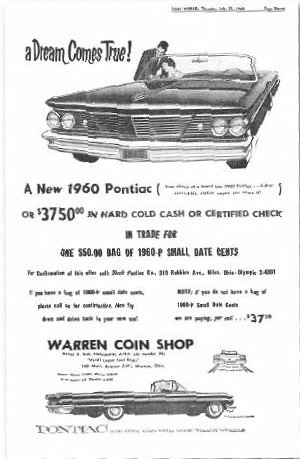
Coin World 1960 Copyright photo, published by permission.
QUERY: WORLD'S GREATEST COLLECTION 1828 QUARTER BUYER SOUGHT
Rory Rea writes:Does anyone know who might possibly own the bid book from the "World's Greatest Collection of U.S. Quarters and 20 Cent Pieces" (Part II, March 3, 1945? The collection was sold at the Numismatic Gallery under the direction of Abe Kosoff and Abner Kreisberg in New York.
I am looking for a name of the person(s) who purchased Lot 95. On page 33 a picture is shown of this ever popular over-fraction 1828 B-3 25 over 50 quarter.
QUERY: FRANK DUPEE STAMPS AND COINS

QUERY: 1976 MONTREAL BRITISH OLYMPIC ASSOCIATION MEDAL
Joe Levine writes:
Does anyone know anything about this Montreal Olympics silver medal? The owner says that there were only six struck in silver.


QUERY: REVIEW OF NUMISMATICS AND THE LAW
I came across this interesting little periodical while cleaning some files recently. It's the "Review of Numismatics and the Law". Pictured is the cover of volume 1, number 1, dated Summer-Fall, 1981. At some point the publication changed its name to "The Counsellor" (subtitled, "A Review of Numismatics and the Law"). I have four individual issues, the last of which is also pictured (v2n2, Summer, 1982).
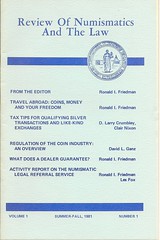
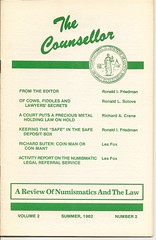
Is anyone familiar with this periodical? If it's defunct, when was the last issue, and how many issues were produced? Is it scarce? The issues have some interesting content. It was published by newsletter author Les Fox, and "named names" of dealers accused of fraud and upbraids numismatic publications such as Coin World and Numismatic News for accepting ads from what it felt were questionable dealers.
MORE ON THE MODEL FOR DRAPED BUST COINAGE
In addition to the sources cited in the E-Sylum article, I would refer interested readers to the following:
Evans, Dorinda, The Genius of Gilbert Stuart, Chapter 5: “The Years in Philadelphia,” 1999
Henry, Red, “The Girl on the Bust Coins: Anne Willing Bingham of Philadelphia,” http://www.nsdr.org/march2001.htm,December 21, 2002.
Jones, Bill, “Stuart and the Phillie Socialite,” The Numismatist, June 1996
Mason, George C., The Life and Works of Gilbert Stuart, 1879.
Stuart, Jane, “Stuart Portraits of Washington, “ Scribner's Monthly, July 1876, pp. 367-374; “Anecdotes of Gilbert Stuart, “Scribner's Monthly, July 1877, pp. 376-382.
I found no references to sketches for Draped Bust coinage in these sources.
Also see my write-up on this issue in The Jules Reiver Collection, Vol. III, Heritage Auction Galleries, January 2006 Signature Sale, pp. 111-115.
I'd like to add some comments about the Anne Bingham / Gilbert Stuart connection with the Draped Bust coinage which began in 1795. There is no recorded connection with the United States Mint, or payment warrants issued for any works created by artist Gilbert Stuart, from any U.S. Mint Director in the 1790's.
Having read all of the previous numismatic background information regarding Anne Bingham (as outlined in the collective seen in last week's E-Sylum), I have spent much time and effort in trying to learn more about her. The search led me from the numismatic writings (unfortunately quite subjective and not substantiated) to a wonderful 1969 book of 570 pages written by Robert C. Alberts, titled, "The Golden Voyage - The Life and Times of William Bingham 1752-1804".
Several images coming from Stuart (of the Bingham's, President Washington, and others), including the 1785 sketch of Anne seen in last week's E-Sylum, were presented in his encompassing book.
William Bingham was associated with Robert Morris, Thomas Willing, and Robert Gilmor, Sr. They were wealthy merchants (with Willing the head of the Bank of the United States) and influenced the outcome of many activities both during and after the American Revolution.
After traveling in Europe in the 1780's, where they first met Stuart in London, the wealthy Bingham's settled in Philadelphia and soon became the leading socialites of the city, giving extravagant parties and receiving important foreign guests. They were good friends of President and Mrs. Washington. A romanticized painting of Lady Washington's Reception, showing Anne Bingham as a dominant center of attention, was done by Daniel P. Huntington.
In 1795, William Bingham was elected as a United States Senator from Pennsylvania. To commemorate his election, Bingham, the richest man in America at the time, had a portrait done by Stuart, who had moved to Germantown (outside Philadelphia) in 1794, after being hounded by creditors in Ireland and New York. He also commissioned Stuart to do a full length portrait of his wife immediately following his "sitting". This seldom seen image was kept in the family by Anne Bingham's cousin, Joshua Francis Fisher. It was so well hidden from public view that Alberts did not know of its existence and omitted it from his book. An 1850's engraving of this Stuart portrait is presented on the rear cover of the dust jacket on my book titled, "Henry Voigt and Others, Involved with America's Early Coinage". This hardbound book is available from me for $65 if anyone is interested.
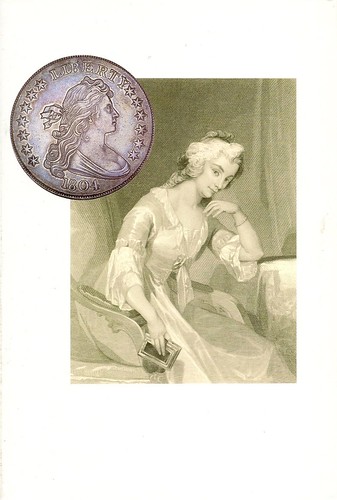
This wonderful portrait done by Stuart was in all probability the contemporary image used by assistant engraver John Eckstein for the "two models for dollars", with Anne Bingham's features (BB-51 and BB-52) that he prepared the dies (probably including the small eagle motif seen on the reverse), for which he was paid $30 on September 9, 1795, by Mint Director Henry DeSaussure.
In April 1796, the Bingham's (Anne in particular) persuaded President Washington to "sit" at Stuart's studio at 6th and Chestnut, for a full length portrait (5 feet by 8 feet) to be given to one of her friends, Lord Landsdowne. Stuart's portrait of the President was the now famous "Landsdowne" portrait where Washington is standing, has his right hand extended, is wearing a full length coat, along with holding his court sword with his left hand, and is in civilian attire.
On March 4, 1797, Senator Bingham, then Sente pro tempore, administered the oath of office to Vice-President elect, Thomas Jefferson in Philadelphia. Later, in the summer of 1797, Robert Gilmor, Jr., one of the earliest American coin collectors and son of one of Bingham's business partners, visited with Bingham's after he graduated from Dickinson College. During his stay, on July 27, 1797, Gilmor visited with Stuart in Germantown and saw the portrait of Washington and many other "distinguished characters". According to Gilmor, Jr., who was staying with the Bingham's later that September when another outbreak of Yellow Fever was invading Philadelphia, Stuart was spending considerable time at the Bingham residence trying to paint the entire family.
It is believed by this writer that his association with seeing the newly designed coinage in circulation, along with viewing the paintings of someone he had known as a personal friend (Anne Bingham), created his interest in saving the "older coins" when he became old enough to appreciate them as a collectible, like paintings, instead of regarding them simply as "spending money".
During the winter of 1801, Anne Bingham caught pneumonia while on a sledding party. This quickly turned into tuberculosis, or what was then called "galloping consumption". William, then in Washington getting ready for Thomas Jefferson's Presidential inauguration, received word of Anne's condition and left immediately to return to Philadelphia. It was the unfortunate end of William Bingham's political career.
Anne's condition worsened so much that on April 13th, she was placed on one of Bingham's vessels, America, and it set course for the island of Madeira to see if her health would recover. Because Anne was losing ground, William changed the ship's destination to Bermuda, which was reached on May 7th. Sadly, she died four days later, and was buried in the main parishioners' section of old St. Peter's churchyard, on a hill overlooking the St. George harbor. Anne Bingham was 36 years old.
For those interested in the 18th century goings-on in America, one needs to look outside of the narrow focus and sometimes self-created versions of history presented in numismatic texts, to find the missing, and often-times correct and interesting answers, to the questions surrounding early American coinage and its' collectors.
To read the earlier E-Sylum article, see: QUERY: WAS GILBERT STUART SKETCH THE MODEL FOR DRAPED BUST COINAGE? (www.coinbooks.org/esylum_v13n13a15.html)
MORE ON WARD SMITH'S PAPER MONEY PUBLICATIONS
Joe Boling writes:
The earlier book published by Universal Publishing Co of Port Washington NY was Dr. Walter Loeb's "Catalog of Paper Money Around the World." It was 75 pages, saddle stitched with card covers, published in 1961. In my inventory it is annotated as "one of the pioneer world paper money catalogs." Both of my copies were donated to the American Numismatic Association some years ago.
The Sten "ENCYCLOPEDIA of WORLD PAPER MONEY: An ILLUSTRATED GUIDE-INDEX Compiled as an aid in the IDENTIFICATION and TRANSLATION of all CURRENCY 1661-1964," known in short as the "Sten Encyclopedia," is all that Bruce described and more. Sten was apparently of Eastern European origin, and seemed to know Cyrillic scripts well. There are very useful transliteration tables for same, in different fonts, which I have referred to many, many times. There are also extensive listings of titles from Russian and other Cyrillic-inscribed notes. My copy of the original 1965 edition is tabbed, faded, and loved.
I also had the 1965/1972 edition, published in Port Washington / Roslyn NY, and attributed in my inventory as "Jolie Coins reprint."
The two-volumes-in-one reprint of Sten's "Banknotes of the World" (the book of which volumes 3 and 4 were lost at his death) was distributed in the US by Jolie Coins, and I have always assumed that they also reprinted it.
All of my Stens, save the tabbed volume mentioned above, also went to the ANA.
I could go on about Dr. Loeb, whom I never met, but fragments of whose collection I acquired after his death. The world paper money fraternity was pretty small in the late '60s.
To read the earlier E-Sylum article, see: MORE ON SHIRJIEH PUBLISHERS AND COPYRIGHTS (www.coinbooks.org/esylum_v13n13a18.html)
THE BOOK BAZARRE
THE BOB CLARKE STORY
Roger deWardt Lane writes:
Reading last week's E-Sylum, which as usual was great, reminded me of a page posted on my web site - The Clarke Story.
I wish KP Publications would find the old 1970's columns of Bob Clarke and republish them or even make a CD of them. With all the interest on Iran they may be timely again. I have over thirty of Clarke's small Persian (Iran) silver coins in my collection. Some of them are scanned, but most are not, which is why only three are posted.
Between 1970 and his retirement in1977, Robert L. Clarke was the Vice President and Resident Manager of the Union Oil Company assigned to Tehran, Iran. During much of this period, he wrote a weekly coin newspaper column for the Krause Publications' Numismatic News.
As a coin collector of world numismatics, I looked forward each week to his travels during vacations to countries in the Near East or to his discussions of weekly visits to the Tehran bazaar to look for coins.
Bob Clarke was the author of several numismatic books including "Minted Coins of Iran", "Swiss Coinage" and "Coins and Tokens of British Oceania," and "India's 1862 Rupee" and "Modern Coinage of Iran" with Dr. Mohabat-Avin and wrote a regular column published in Numismatic News in the early ‘70's.
The dealer said, “I have a whole collection of Iranian coins”. He quickly produced a three-ring notebook with the usual plastic pages of coins in 2x2s. Since they were arranged in the usual manor of crowns first, followed by the smaller denominations in order of size, I turned to near the back of the book, to look for 500 dinars,1 rials and white shari pieces. There were several pages of very interesting coins.
At this point I learned that the dealer did not wish to break up the collection, rather sell the whole book as a lot. Very disappointed, I thanked him and walked away. The dealer who had a table next to him was a very steady dealer and good friend; I knew him, through both the Hollywood and Ft. Lauderdale Coin Clubs. Since he had overheard my inquiry about the collection and being a full time dealer in world coins himself, I later learned he bought the whole collection.
At the next show, the new owner of the Persian collection let me cherry pick most of the coins I could afford and needed to add to my own dime-size date collection. I was very grateful for this. One group of these small size coins, however, I passed up, as they had been mounted or holed.
Years later, I did acquire this group of holed coins from him, as I still did not have an example by date of them , so the coins shown must be very rare. They were the only specimens available to Bob Clarke in Tehran in the 70's for his collection. I have collected this series for forty years, visiting large shows and ordering by mail at times. Next to China, the Persian/Iran series is the most difficulty to complete by date.
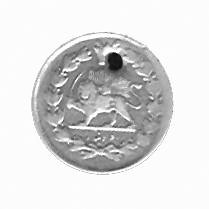

To read the complete article, see: The Bob Clarke Story (www.dewardt.net/clarke/clarke%20story.html)
THE COPYRIGHT REVIEW MANAGEMENT SYSTEM
The Copyright Review Management System project, at the University of Michigan has taken on the task of identifying books published in the United States from 1923 to 1963 that have entered into the public domain. The works that they find to be in the public domain, they are digitizing and adding to the HathiTrust Free Library catalog for all to access.
Since 2007, the University of Michigan has devoted staff in its Technical Services Division to determining the copyright status of such works. The CRMS project is meant to build on that experience by increasing the reliability of copyright status determinations, creating a point of collaboration for other institutions, and ultimately aiding in the process of making vast numbers of additional books available online to the general public.
The project is currently in Phase Two, which is scheduled to run from June 2009 through May 2010. Version 1.0 of the CRMS was released on July 10, 2009. Last reported, Technical Services staff have reviewed over 14,000 volumes in the HathiTrust Digital Library using the CRMS. Of those volumes, over 8000 (approximately 58%) have been determined to be in the public domain.
The texts of those volumes are now publicly accessible via Mirlyn (Michigan's OPAC - http://mirlyn.lib.umich.edu) as well as in the HathiTrust Digital Library (http://catalog.hathitrust.org/). Two reviewers now review each volume, and an expert arbitrator makes a final determination for any conflicting reviews.
Currently CRMS is hard at work developing version 2.0 of the CRMS. Development and testing is scheduled through the spring, with a target release date of May 2010. They are also preparing to train and add reviewers from three other institutions (Indiana University, University of Minnesota and University of Wisconsin), who will be joining the project starting this summer.
For more detailed information on the project, here is a link to the project website: www.lib.umich.edu/copyright-review-management-system
LECTURE BY AUTHOR OF "A GENTLE MADNESS"
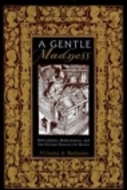 I was lucky to hear a lecture at the Clements Library in Ann Arbor, MI by Nick Basbanes (author of "A Gentle Madness: Bibliophiles, Bibliomanes, and the Eternal Passion for Books"). It was also nice to see another NBS member in the audience (David Davis).
I was lucky to hear a lecture at the Clements Library in Ann Arbor, MI by Nick Basbanes (author of "A Gentle Madness: Bibliophiles, Bibliomanes, and the Eternal Passion for Books"). It was also nice to see another NBS member in the audience (David Davis).
I already knew that Basbanes is a good writer. It turns out he's also a wonderful speaker. He told stories of books, collectors, libraries, and more. The stories about Steven Blumberg were amazing. He also told about interesting encounters while doing research for a book he's writing about paper itself. One quotation he mentioned was one I had read in his book years ago but bringing it to the surface struck a chord (as someone who just moved and is dealing with my collections en masse):
"The bibliophile is the master of his books, the bibliomaniac their
slave"
Hanns Bohatta
Dan adds:
The Clements Library has a half dozen Indian peace medals (all copper or bronze) and a couple of contemporary illustrations of Peace Medals being worn in their current exhibit:
www.clements.umich.edu/Exhibits/nativeamerican/
nativeamerican.html.
NOTES FROM E-SYLUM READERS APRIL 4, 2010
Dave Hirt writes:
On the 1909 proof cents in the J.S. Jenks catalog. They really did NOT sell for under face value. I pulled my copy. Under Terms and Conditions, each lot is sold so much per PIECE, except proof sets. So the 14 pieces sold for 5 cents EACH, or 70 cents.
Jim Duncan writes:
That word FIRST in relation to the Victoria Cross should, I think, have been qualified in the heading. The very first Victoria Cross was, as I understand it, awarded to Seaman Charles Lucas, 18 years old, who picked up and threw overboard a Russian shell with the fuse still burning, thus saving his ship, HMS Hecla, 21 June, 1854. He eventually became a Rear Admiral.
Twenty-four Crosses were awarded by Queen Victoria at the first investiture held in 1857. Surely, the first went to a Navy man who would have gotten a blue ribboned Cross. (This changed to the claret colour with the advent of the Royal Air Force). The American Unknown Warrior of WWI was awarded a Cross too.
Tony Hine adds:
The largest collection of Victoria Cross medals is currently held by Lord Michael Ashcroft, Baron of Chichester, who is deputy Chairman of the Conservative Party in Great Britain, and a prolific writer on VC medals, and other causes he chooses to champion. See www.michaelashcroft.com for links to his articles.
MORE COIN CABINETS
Jim Wells writes:
Craig McDonald wrote about wooden Coin Cabinets in the March 21 E-Sylum, and asked for photos of others. I have photographed some doozies in some museums.

This 48-drawer coin cabinet in the Kunsthistorisches Museum in Vienna (about 3 feet tall, some coins visible in open drawers)
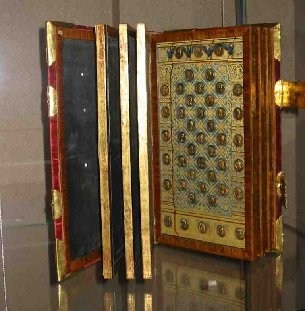
and this 7-page (wooden?) "coin folder" showing 45 gold coins on one page, same Vienna museum
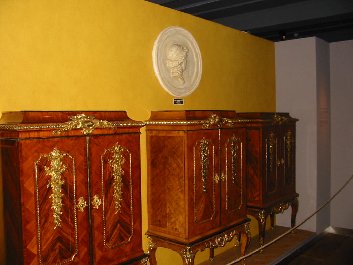
These coin cabinets of the Swedish kings, now in the Swedish National Museum of Monetary History in Stockholm (http://www.myntkabinettet.se/web/English.aspx).
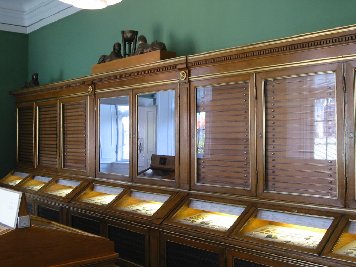
and these of Danish Kings, now in the National Museum of Denmark in Copenhagen, Royal Collection of Coins and Medals (http://www.nationalmuseet.dk/sw33853.asp).
Jim adds:
... and I wish I had my grandfather's glorious mahogany coin cabinet with dozens of felt-lined drawers from which he started me in collecting ...
To read the earlier E-Sylum article, see: A FRENCH COIN CABINET C1809-19 BY JACOB-DESMALTER (www.coinbooks.org/esylum_v13n13a13.html)
THE BOOK BAZARRE
MACEDONIAN ARCHAEOLOGISTS DISCOVER ANCIENT COINS NEAR OHRID
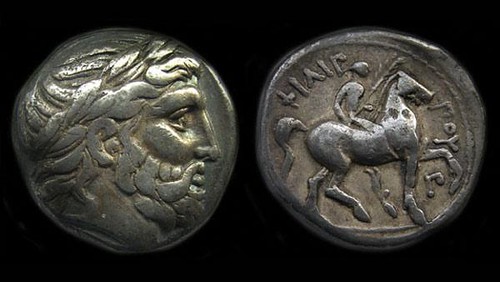
Around 20 coins with the image of the father of Alexander the Great, Philip II of Macedon, and “other ancient Macedonian rulers” were found by archaeologists during excavations along the road between the south-western Macedonian towns of Ohrid and Struga, national media reported today.
In addition to the coins, a space with around 1,000 arrows was also discovered, Director of the Cultural Heritage Protection Office Pasko Kuzman told the Alsat-M television station.
The archaeological find was made in the vicinity of the Cyclops Fortress, which – according to Kuzman, dates to the 358 BC when Philip II passed through the area with his army. The fortress, he added, was a strategic military position for the ruler's army.
Although Philip II of Macedon's biggest claim to historical claim is perhaps his fathering of Alexander the Great, the ancient Greek personage (382 – 336 BC) was a great ruler and military strategist in his own right, who largely realised his expansionist vision.
To read the complete article, see: Macedonian Archaeologists Discover Ancient Coins near Ohrid (www.balkantravellers.com/en/read/article/1857)
COMPUTERS AT THE CORE OF PCGS' NEW GRADING SERVICE OFFERING
This week, the Professional Coin Grading Service announced “The Big One,” a service called PCGS Secure Plus.™ A new service line that will be an option for most collectors except for rare and ultra rare coins which must be certified by PCGS Secure Plus. The significant part of this service is that PCGS is adding modern computer imaging to coin grading.
Coins grade through Secure Plus will be scanned by an optical device that will map the surface of the coin creating a digital signature of its characteristics that can be used for later reference. The digital signature is a unique identification of the coin that can withstand potential coin doctoring and to prevent the users from removing the coin from the slab to try to have it graded higher. It can also be used to determine if the coin was doctored from its previous submission such as being artificially toned.
During the announcement PCGS President David Hall (videos Part 1 Part 2) said that this should end “gradeflation” as well as work out errors in the population reports when people submit coins multiple times. Hall said that multiple submissions did not serve the industry and hope that this would end the practice. Hall noted “We did not start PCGS to grade a coin 40 times.”
Hall said that PCGS has been working on this service for two years with “industry leaders” who were not mentioned. However, in the follow up presentation by PCGS CEO Don Willis (videos Part 3 and Part 4), his technical explanation included an image of the CoinSecure, Inc. to use the CP16 CoinAnalyzer. During his part of the announcement, Willis said that the process is being patented.
Having been an advocate for computer based grading, this is a great start to using technology to assist in grading. Add the ability to digitally fingerprint the coin to prevent coin doctoring and crackout artists from resubmitting the coins multiple times hoping for better grades, PCGS has created “The Big One” in the world of third party grading.
To read the complete article, see: PCGS's Big One, PCGS Secure Plus™, Is A Big Deal (coinsblog.blogspot.com/2010/03/pcgss-big-one-is-big-deal.html)
For more background on the new service, see the video interviews at CoinTelevision.com. Executive Producer David Lisot writes:
Hear Don Willis, PCGS president, and David Hall, PCGS founder, talk about the new service. Listen to the response from different people in the coin trade including some of the major auction houses, market makers, and regular coin dealers.
Click here to view the videos: cointelevision.com/archive-2010-ana_ftw.html
GERALD BLANCHARD, HIGH-TECH BANK ROBBER
Blanchard began mastering the workings of myriad mechanical devices and electronics. He became obsessed with cameras and surveillance: documenting targets, his own exploits, and his huge piles of money. Befitting a young tech enthusiast, he emptied an entire RadioShack one Easter Sunday. At age 16, he bought a house with more than $100,000 in cash. (He hired a lawyer to handle the money and sign the deal on his behalf.)
In 2001, Blanchard was driving around Edmonton when he saw a new branch of the Alberta Treasury bank going up. His internal algorithm calculated low risk, and he began to case the target meticulously.
As the bank was being built, Blanchard frequently sneaked inside — sometimes at night, sometimes in broad daylight, disguised as a delivery person or construction worker. There's less security before the money shows up, and that allowed Blanchard to plant various surveillance devices in the ATM room. He knew when the cash machines were installed and what kind of locks they had. He ordered the same locks online and reverse engineered them at home. Later he returned to the Alberta Treasury to disassemble, disable, and remount the locks.
The take at this bank was a modest 60 grand, but the thrill mattered more than the money anyway. Blanchard's ambition flowered, as did his technique.
Blanchard targeted a half-dozen banks over the next few years. He'd get in through the air-conditioning ductwork, at times contorting his body to fit inside really tight spaces. Other times, he would pick the locks. If there were infrared sensors, he'd use IR goggles to see the beams. Or he'd simply fool the sensor by blocking the beam with a lead film bag.
He assembled an arsenal of tools: night-vision cameras, long-range lenses, high-gain antennas that could pick up the feeds from the audio and video recorders he hid inside a bank, scanners programmed with the encryption keys for police frequencies. He always had a burglary kit on hand containing ropes, uniforms, cameras, and microphones. In the Edmonton branch of the Bank of Nova Scotia, which he hit in 2002, he installed a metal panel near the AC ducts to create a secret crawl space that he could disappear into if surprised by police.
Such evasive action was never required, however, in part because Blanchard had also memorized the mechanics of the Mas-Hamilton and La Gard locks that many banks used for their ATMs. (These are big, complicated contraptions, and when police later interrogated Blanchard, they presented him with a Mas-Hamilton lock in dozens of pieces. He stunned them by reassembling it in 40 seconds.)
After midnight on Saturday, May 15, 2004, as the northern prairie winter was finally giving way to spring, Blanchard walked up to the front door of the Canadian Imperial Bank of Commerce in the Mega Centre, a suburban development in Winnipeg. He quickly jimmied the lock, slipped inside, and locked the door behind him. It was a brand-new branch that was set to open for business on Monday, and Blanchard knew that the cash machines had been loaded on Friday.
There were seven machines, each with four drawers. He set to work quickly, using just the right technique to spring the machines open without causing any telltale damage. Well rehearsed, Blanchard wheeled out boxes full of cash and several money counters, locked the door behind him, and headed to a van he had parked nearby.
Eight minutes after Blanchard broke into the first ATM, the Winnipeg Police Service arrived in response to the alarm. However, the officers found the doors locked and assumed the alarm had been an error. As the police pronounced the bank secure, Blanchard was zipping away with more than half a million dollars.
After spending so much time chasing Blanchard — and then talking to him — McCormick and Levasseur developed a grudging regard for his abilities. And Blanchard grew to admire their relentless investigation. Like a cornered hacker who trades his black hat for white, Blanchard took on a new challenge: working the system from the inside. He provided such good information that McCormick and Levasseur were able to put together an eight-hour presentation for law enforcement and banking professionals. “When those guys hear what Blanchard told us,” McCormick says, “you can hear their a**holes pucker shut.”
To read the complete article, see: Art of the Steal: On the Trail of World's Most Ingenious Thief (www.wired.com/magazine/2010/03/ff_masterthief_blanchard/all/1)
FEATURED WEB SITE: PLAY MONEY OF AMERICAN CHILDREN
This week's Featured Web site is Play Money of American Children by Richard and Wendy Clothier. It is an online copy of Clothier's 1985 book.
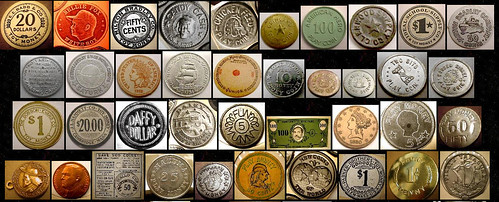
rfc33.tripod.com
